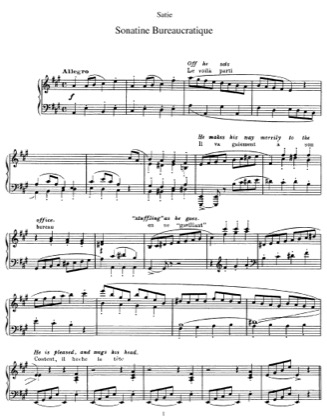Mountain Horn Song, Sz.56
Bartok1,525

This is free piano sheet music for Sonatine bureaucratique, Satie provided by allpianoscores.com
Sonatine bureaucratique or "Bureaucratic sonatina" is a piano composition by Erik Satie, that spoofs the Sonatina Op. 36 N° 1 by Muzio Clementi. Satie's sonatina, even shorter than Clementi's example, was composed July 1917, and published the same year. The composition is in three small-scale movements, of which the last one exposes some pseudo-development: the motifs of the first half of that movement are re-arranged in another sequence by way of "development section", or rather as the imitation of development. From a formal point of view the sonatina is however Satie's most outspoken neoclassical composition. It is one of the exceptional piano compositions he wrote down with bar lines, which he probably would not have done if not for making an explicit reference to classicism. That Satie would write a "neo-classical" composition a few months after the succès de scandale of Parade, is not so surprising either: Satie was on friendly terms with Stravinsky since 1911, and after this composer had had his big succès de scandale in 1913 (premiered with the same Ballets Russes), he also moved towards neoclassicism - although for Stravinsky there was no distinct neoclassical composition published before Satie's sonatina. The partition is full of funny remarks, amongst others the final movement being called "Vivache", instead of the original Vivace ("vache" being French for "cow"). Satie directs at least part of the fun at himself: the sourd muet ("deaf-mute") from Lower Brittany, allegedly having provided the "Peruvian air" that forms the first theme of the last movement, is of course none but Satie himself. The sonatina can also be seen as the composition with which Satie concluded his series of "funny" 3-part solo piano compositions, which had started in 1911 - although Satie himself would of course never say "neo-classicism" not to be serious business.
